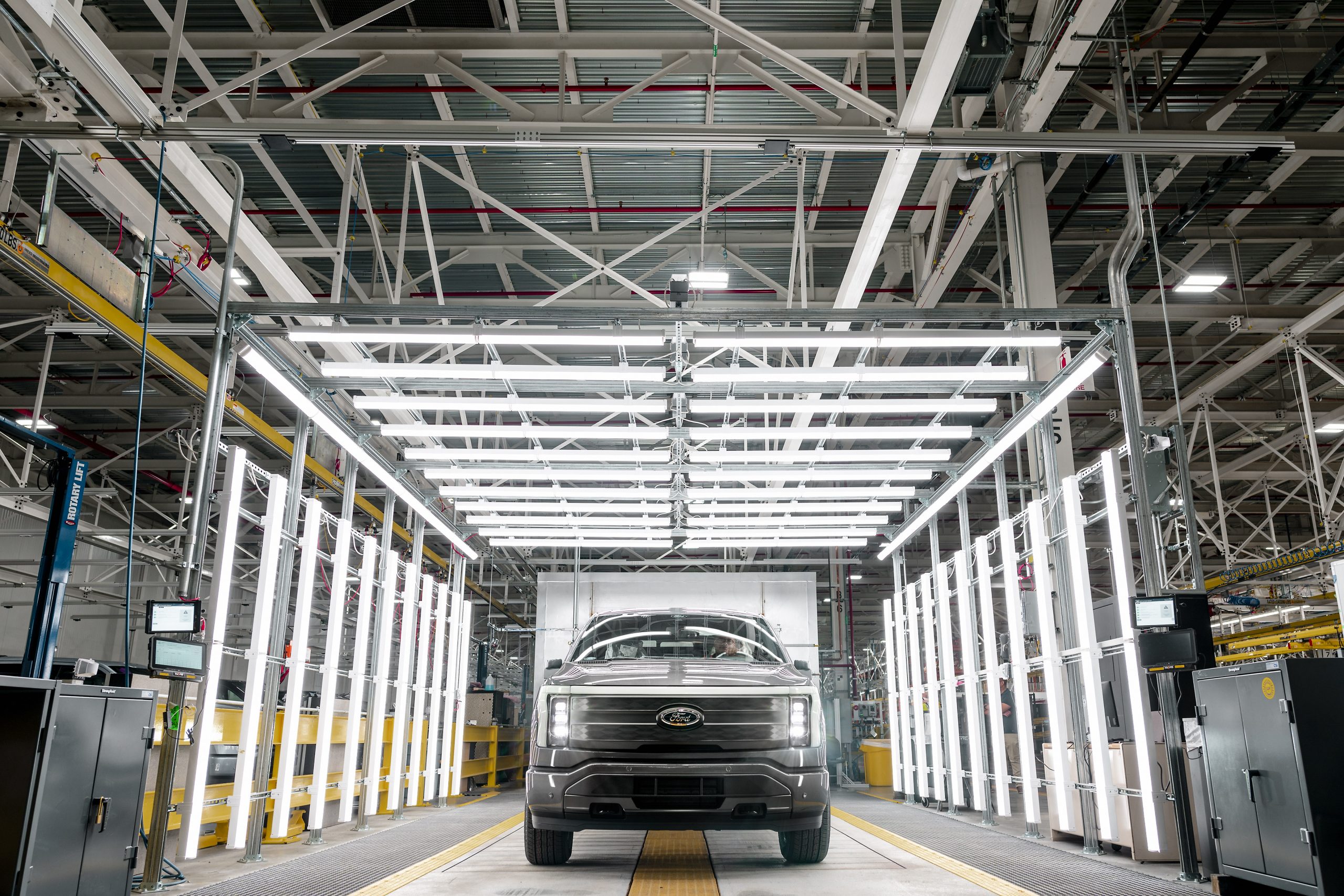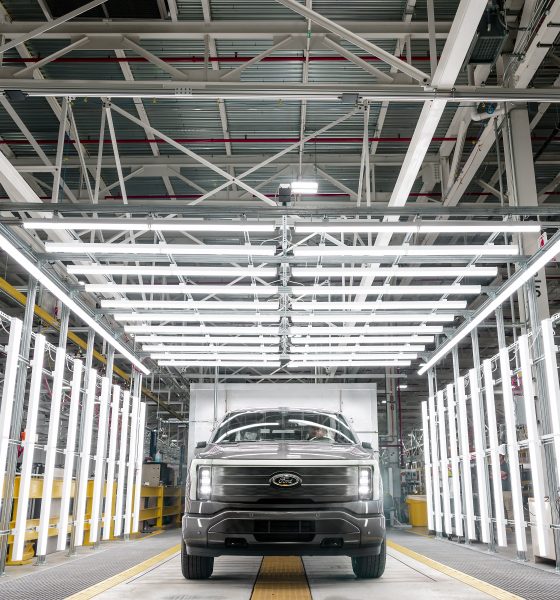

News
Ford’s top brass sit down with Sandy Munro to discuss the F-150 Lightning
Ford CEO Jim Farley and other company executives were interviewed by Sandy Munro earlier this week, highlighting the work done on the F-150 Lightning, its defining features, as well as Ford’s future more generally.
Sandy Munro of Munro Associates runs a YouTube channel where he and his team dive into different models of vehicles and analyze their dependability, durability, and overall engineering design work. However, Sandy and fellow Munro associate Cory Steuben got to sit down with top leaders from Ford, which included Farley, Linda Zhang, who was the Chief Engineer of the all-electric pickup, and Doug Field, the automaker’s Chief Officer of EVs. Mainly focusing on the F-150 Lightning but also talking about the brand’s future and competitors, the interview culminated as Sandy asked the executive team about possible vertical integration within their manufacturing process, possible partnerships with Tesla, and a possible switch to the Tesla connector as the US default.
The video starts with Sandy getting the keys to his new F-150 Lightning, kindly delivered in person by Jim Farley and the team. However, Sandy quickly moves to ask about the truck and its design.
While Sandy was quick to praise the EV drivetrain and the durability of design, foremost thought the interview; the executive team focused on accessory features instead. Doug Field specifically sees the onboard generator, the large frunk, and the bi-directional power (the feature that allows the truck to power the home during a blackout) as the top reasons consumers have flocked to the new truck. Farley continues by noting that, while he didn’t expect the vehicle’s features to be such a crowd pleaser, he believes that they are the reason consumers aren’t asking “why an EV,” but “why not!”
The rest of the interview generally focuses on the market and the Ford brand. The biggest question is the thought of exponential growth in the EV market. Sandy notes explicitly that the US market had recently reached a 5% market share of EVs, what he calls a “tipping point” in the market. Jim responds positively, noting that he is excited about the chance to expand so quickly, expanding older plants such as “The Rouge” and constructing new plants like their new facility in Tennessee to meet demand. Further, he notes he isn’t worried about the brand’s ability to meet demand.
Another big question on the mind of Sandy (and many others who are interested in EVs) is the question of a partnership with Tesla, as well as the executives’ thoughts on the recent proposal to make the Tesla connector the new US standard. “We consider everything,” Doug responds tritely. The team responds to a Tesla partnership, saying that Ford would need a powerful motivating idea to consider abandoning their independence and partnering with another maker, Tesla or otherwise. However, none of the team concretely answered Sandy’s question about standardizing the Tesla Connector.
The group next addresses the possibility of increased verticle integration within their manufacturing. Software, batteries, and powertrain parts were essential parts where they stated the brand would likely continue to pursue verticle integration, going as far as to call other battery makers such as CATL “competitors.” However, Farley notes that he would not compromise the user experience in efforts of verticle integration.
Sandy concludes by lamenting the lack of the $20-$25,000 EV. He mentions that the in-demand Maverick is an excellent example of a vehicle that shows affordable vehicles can still do well and prove profitable for brands like Ford. Doug responds conservatively that, while they see the segment as “very important for global competitiveness,” difficulties remain in acquiring affordable powertrain parts and batteries. And while LFP batteries may offer an avenue into that market, Ford is still in the process of “considering other options.”
Sandy’s interview shows that Ford remains quite dedicated to pursuing EV tech and why they remain ahead of previous rivals such as GM and the Chrysler family of brands. Farley is thinking ahead of many of these other legacy brands, and despite the hurdles that come with that status (cough cough dealerships cough cough), they are positioning themselves well to succeed. Ford’s sales and stock price seem to reflect this.
What do you think of the article? Do you have any comments, questions, or concerns? Shoot me an email at william@teslarati.com. You can also reach me on Twitter @WilliamWritin. If you have news tips, email us at tips@teslarati.com!

News
Tesla FSD fleet is nearing 7 billion total miles, including 2.5 billion city miles
As can be seen on Tesla’s official FSD webpage, vehicles equipped with the system have now navigated over 6.99 billion miles.

Tesla’s Full Self-Driving (Supervised) fleet is closing in on almost 7 billion total miles driven, as per data posted by the company on its official FSD webpage.
These figures hint at the massive scale of data fueling Tesla’s rapid FSD improvements, which have been quite notable as of late.
FSD mileage milestones
As can be seen on Tesla’s official FSD webpage, vehicles equipped with the system have now navigated over 6.99 billion miles. Tesla owner and avid FSD tester Whole Mars Catalog also shared a screenshot indicating that from the nearly 7 billion miles traveled by the FSD fleet, more than 2.5 billion miles were driven inside cities.
City miles are particularly valuable for complex urban scenarios like unprotected turns, pedestrian interactions, and traffic lights. This is also the difference-maker for FSD, as only complex solutions, such as Waymo’s self-driving taxis, operate similarly on inner-city streets. And even then, incidents such as the San Francisco blackouts have proven challenging for sensor-rich vehicles like Waymos.
Tesla’s data edge
Tesla has a number of advantages in the autonomous vehicle sector, one of which is the size of its fleet and the number of vehicles training FSD on real-world roads. Tesla’s nearly 7 billion FSD miles then allow the company to roll out updates that make its vehicles behave like they are being driven by experienced drivers, even if they are operating on their own.
So notable are Tesla’s improvements to FSD that NVIDIA Director of Robotics Jim Fan, after experiencing FSD v14, noted that the system is the first AI that passes what he described as a “Physical Turing Test.”
“Despite knowing exactly how robot learning works, I still find it magical watching the steering wheel turn by itself. First it feels surreal, next it becomes routine. Then, like the smartphone, taking it away actively hurts. This is how humanity gets rewired and glued to god-like technologies,” Fan wrote in a post on X.
News
Tesla starts showing how FSD will change lives in Europe
Local officials tested the system on narrow country roads and were impressed by FSD’s smooth, human-like driving, with some calling the service a game-changer for everyday life in areas that are far from urban centers.

Tesla has launched Europe’s first public shuttle service using Full Self-Driving (Supervised) in the rural Eifelkreis Bitburg-Prüm region of Germany, demonstrating how the technology can restore independence and mobility for people who struggle with limited transport options.
Local officials tested the system on narrow country roads and were impressed by FSD’s smooth, human-like driving, with some calling the service a game-changer for everyday life in areas that are far from urban centers.
Officials see real impact on rural residents
Arzfeld Mayor Johannes Kuhl and District Administrator Andreas Kruppert personally tested the Tesla shuttle service. This allowed them to see just how well FSD navigated winding lanes and rural roads confidently. Kruppert said, “Autonomous driving sounds like science fiction to many, but we simply see here that it works totally well in rural regions too.” Kuhl, for his part, also noted that FSD “feels like a very experienced driver.”
The pilot complements the area’s “Citizen Bus” program, which provides on-demand rides for elderly residents who can no longer drive themselves. Tesla Europe shared a video of a demonstration of the service, highlighting how FSD gives people their freedom back, even in places where public transport is not as prevalent.
What the Ministry for Economic Affairs and Transport says
Rhineland-Palatinate’s Minister Daniela Schmitt supported the project, praising the collaboration that made this “first of its kind in Europe” possible. As per the ministry, the rural rollout for the service shows FSD’s potential beyond major cities, and it delivers tangible benefits like grocery runs, doctor visits, and social connections for isolated residents.
“Reliable and flexible mobility is especially vital in rural areas. With the launch of a shuttle service using self-driving vehicles (FSD supervised) by Tesla in the Eifelkreis Bitburg-Prüm, an innovative pilot project is now getting underway that complements local community bus services. It is the first project of its kind in Europe.
“The result is a real gain for rural mobility: greater accessibility, more flexibility and tangible benefits for everyday life. A strong signal for innovation, cooperation and future-oriented mobility beyond urban centers,” the ministry wrote in a LinkedIn post.
News
Tesla China quietly posts Robotaxi-related job listing
Tesla China is currently seeking a Low Voltage Electrical Engineer to work on circuit board design for the company’s autonomous vehicles.

Tesla has posted a new job listing in Shanghai explicitly tied to its Robotaxi program, fueling speculation that the company is preparing to launch its dedicated autonomous ride-hailing service in China.
As noted in the listing, Tesla China is currently seeking a Low Voltage Electrical Engineer to work on circuit board design for the company’s autonomous vehicles.
Robotaxi-specific role
The listing, which was shared on social media platform X by industry watcher @tslaming, suggested that Tesla China is looking to fill the role urgently. The job listing itself specifically mentions that the person hired for the role will be working on the Low Voltage Hardware team, which would design the circuit boards that would serve as the nervous system of the Robotaxi.
Key tasks for the role, as indicated in the job listing, include collaboration with PCB layout, firmware, mechanical, program management, and validation teams, among other responsibilities. The role is based in Shanghai.
China Robotaxi launch
China represents a massive potential market for robotaxis, with its dense urban centers and supportive policies in select cities. Tesla has limited permission to roll out FSD in the country, though despite this, its vehicles have been hailed as among the best in the market when it comes to autonomous features. So far, at least, it appears that China supports Tesla’s FSD and Robotaxi rollout.
This was hinted at in November, when Tesla brought the Cybercab to the 8th China International Import Expo (CIIE) in Shanghai, marking the first time that the autonomous two-seater was brought to the Asia-Pacific region. The vehicle, despite not having a release date in China, received a significant amount of interest among the event’s attendees.








